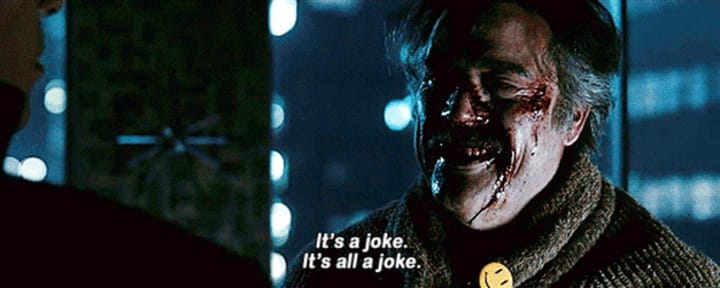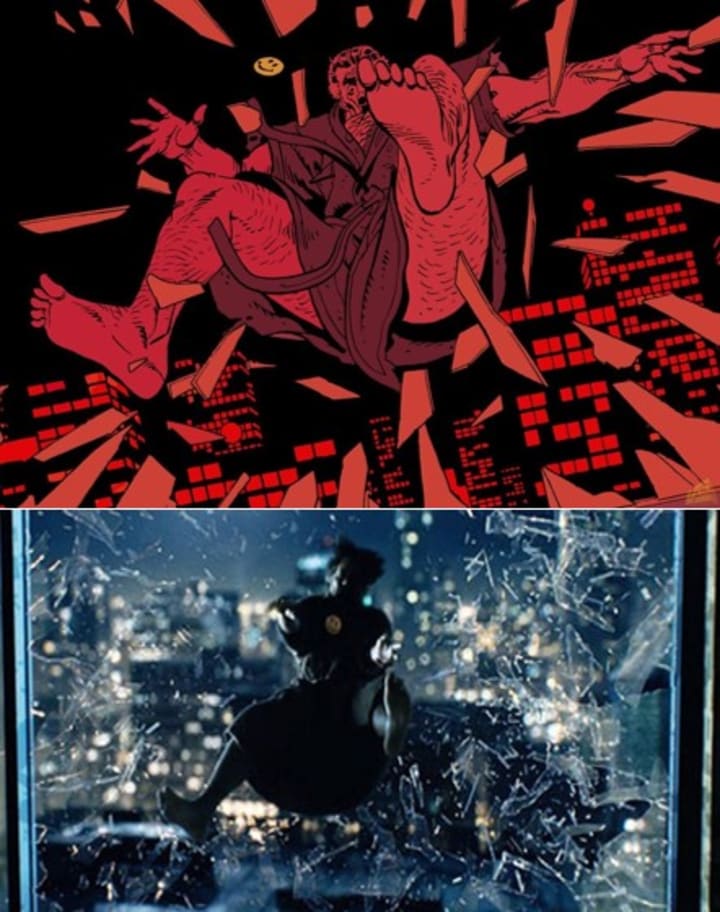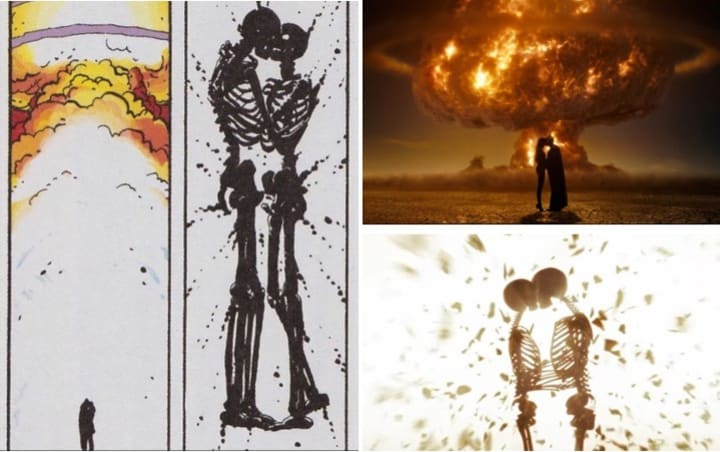
It’s 2022 and I’m ready to tackle Zack Snyder’s 2009 Watchmen. What a time to be alive! I studied the DC graphic novel Watchmen by Alan Moore and Dave Gibbons not only once, but twice (once in high school and again in university), so I’ve pretty much been ready to talk and write about the film for ages… so here we finally are! An important piece to note going forward as it wasn’t mentioned in my Batman piece “The Mind Blowing Aspects of Batman Begins & The Dark Knight”, is that I’m a huge DC fan and it’s DC > Marvel for me. But how did that come to be? Why do I just love the nitty-gritty dark and light of DC? Well, it all started seven years ago when I studied this graphic novel called… Watchmen. When I first read this graphic novel I found its message to be so real, and once I watched the film shortly after, I quite liked it. I then decided to watch Christopher Nolan’s Batman series again and noticed it held the same message, albeit with a slightly altered delivery. It is worth noting that I have yet to read the Batman graphic novels. When I finally read V for Vendetta I loved it just as much for the exact aforementioned reasons, but when I watched the film I wasn’t such a fan (but that’s a story for another time… keep a look out!). But Watchmen… something about this graphic novel truly made it one of my all-time favourite books/stories/graphic novels, and all this just begs the already asked question both by my high school English 12 Teacher and one of my university English Literature Professor’s: “how does the film compare to the graphic novel?”. Well today folks, we will find out!

Okay first things first, one of the top reasons I love Watchmen in both its mediums is because they truly are quite similar. The film boasts a time frame of three hours, so it really makes an effort in trying to contain as much detail and events that occur in the graphic novel. But of course, “books are better than films.” But, it is worth noting that is only ever the case because most books aren’t constrained to a reading time of 1-3 hours, so of course the book will give you more than a film can! However, despite the films missing pieces it does a pretty good job at getting the major events and themes across and, sheds some light on whatever “smaller” (albeit big enough in the book) pieces when it can. Overall, I give the film a solid 8/10 and the graphic novel is clearly, 10/10. So now let’s talk some details!
If you’re at all familiar with the Hero-complex publishers DC Comics and Marvel Comics, you already know there is a big difference between the two. To me Marvel stories are superhero stories for kids – they're pretty PG-13 and the hero is always the good guy down to a tee and without a doubt. Yet DC Comics is the complete opposite – they’re usually R-rated, nitty-gritty, dark, and involve superhero’s who often are normal people without “powers”, and who play both the good and bad guy though their heart is always in the right place! The nitty-gritty and dark theme DC showcases both in its novels and films are its authors and illustrators’ point of view on society – and it’s dark, clearly. This “true” reflection of society and the world in which we live in is put on paper and heck sometimes even on film, but it’s to showcase to the world within the story and in our own reality that the world is a dark and cruel place, and the only way to save it is to use a bit of dark so that we can finally see the light. A perfect example of this is the Restart Theory: that in order for the greater good to be achieved, destruction must come first. This is evident in many DC storylines, and it’s here in Watchmen too. Now do I agree with such a theory? I’m not too sure, but that’s not what we’re here to talk about – although I will say, I believe The Comedian’s POV is correct.

Another big tell in DC stories is symbolism. Extremely noticeable in Watchmen, symbolism is used to remind the viewer or perhaps even show the viewer or reader that everything is connected, even if disconnected by time. The infamous smiley face pin with blood splatter is at the center of the Watchmen story, and we see it countless times in slight variations – but we always know what it means. Whether it’s the original pin with its new-found blood splatter that’s fallen off The Comedian, the smiley face on Mars created by Dr. Manhattan’s construction, or the BBQ sauce falling off a sandwich and onto the smiley face shirt of the man eating said sandwich, we link the symbol to the setting, the characters involved, and the overarching theme and storyline. The same can be said for the V symbol or mask in V for Vendetta, or the Bat Signal in Batman – we know what it means no matter where or which version we see (if you know you know, and if you don’t then watch the film and/or read the graphic novel). What’s more? The fact that such symbolism is usually greatly recreated for the film versions of these graphic novels – adding another point to Watchmen film scoreboard.

Now you must be wondering, “what did the film get wrong?” or “what did the film not mention?”. The short and sweet answer to the former is some ideas are difficult to portray, period. A classic example of this is time – something that is very skewed in Watchmen because we come to learn that time is relative, that all things are happening at once, and certain characters are in more places than one. So how do you even showcase that, in a not-so confusing way? Well let me tell you, it was difficult and confusing in the graphic novel, and therefore was shortened and alluded too only a couple times in the film – with Dr. Manhattan at the funeral being a tell because the camera zooms in and out of his face and setting so as to find him looking at different things and being in a different place each time it occurs, though Dr. Manhattan’s face never changes in any of the scenarios. Moving on to the latter, some “smaller” storylines were definitely missing or only had its surface scratched in the film, however for time constraint purposes one can see why such a thing has occurred. The best examples of this would be the pirate comic a kid reads throughout the novel whose presence is obsolete in the film, and the “end of the world sign guy” who’s presence is barely seen in the film but is very present in the graphic novel. What omitting or reducing these storylines for the film means, is that we lose vital backstory when it comes to properly describing and portraying the overarching theme and message Watchmen was written to exude and tell! Are they absolutely necessary for the film? No, but would they make the film better? Yes. Why? Because the viewer will have a greater sense of the chaos and horror that exists in the world around the characters, and why the protagonists need to do what they do. Sure, we know heroes are needed to fight crime, injustices and save the weak, but what those crimes and injustices truly are we hardly know but what mere and brief news headlines tell us. Long story short we get by, but it really is better to have the complete backstory so viewers can feel the depth the Watchmen storyline actually has. Every DC graphic novel is much darker and heavier than its film counterpart, so it’s a shame people who haven’t read the novels will never know that, and that is probably the best reason as to why the films cannot compete with the graphic novels, not matter how hard they try. I will say however, that Watchmen shows us much more of the dark underbelly of its graphic novel than any other DC film I’ve seen whose novel I’ve also read (I’d like to say Sin City does a good job as well but, I haven’t read it) – which is exactly why Watchmen is the best rendition of a DC graphic novel to me anyway, given my familiarity within the DC graphic novel space (which I am still working on expanding!).
Last but definitely not least, we need to talk about graphics! The illustrations in a comic book or graphic novel are just as important as the words on the page when it comes to novels such as these, and that is precisely why the illustrators and even colourists are mentioned with the author, every time. The imagery tells a story as much as the words do, so if we’re turning such a book into a film one would assume we’d see similar imagery. If you're familiar with any graphic novel or comic book, you know the imagery is of a different style to what one might find in a picture book – they are bold, intense, graphic, and can be as telling as words because sometimes, we don’t even get any words! That said, what I liked about Watchmen the film, was that it made numerous strides in replicating the graphics from the novel and bringing it to life in the film. And for someone like me who has studied this graphic novel twice and knows the impact of its imagery, I appreciate the attempts made! So now, I bid all you readers farewell with some clear and epic examples:


If you liked this piece, are a DC fan or want more pieces like this, let me know with a heart, tip, or comment. Thank you readers!
#watchmen #DCcomics #ZackSnyder #film #filmreview #commentary #filmcritique #graphicnovel #AlanMoore #DaveGibbons #movievsbook #movievsgraphicnovel #dark #action #trippymovies #superhero #DCvsMarvel #superheromovies #goodvsbad #goodvsevil #lightvsdark #thecomedian #drmanhattan #nightowl #silkspectre #rorschach #MatthewGoode #PatrickWilson #MalinAkerman #JeffreyDeanMorgan #BillyCrudup #JackieEarleHaley #CarlaGugino
About the Creator
Saira
Aloha fellow film & series lovers!
I'm here to write & share my POVs & love of movie making with you all. I tackle basically ALL genres, so if you're ever trying to decide what to watch next, 100% my page will help.
Happy watching & reading!






Comments
There are no comments for this story
Be the first to respond and start the conversation.